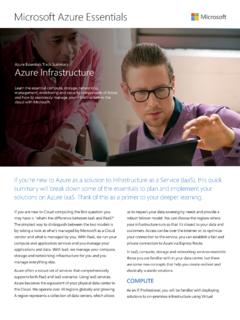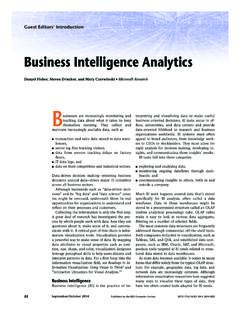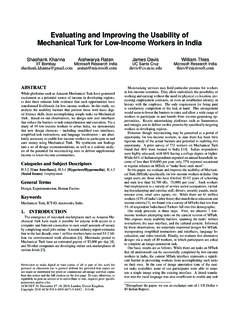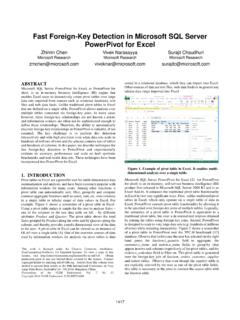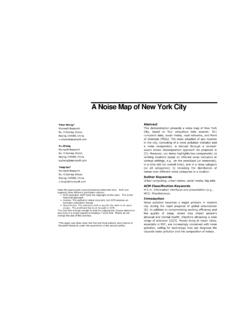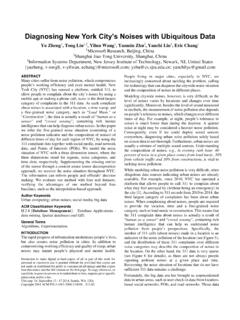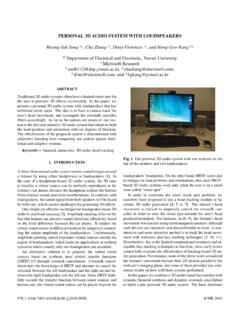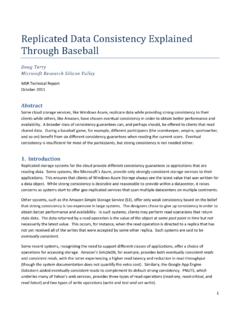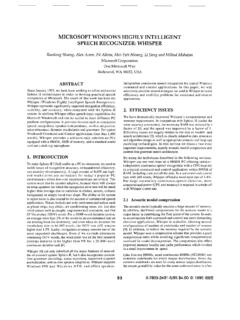Transcription of MSR-VTT: A Large Video Description Dataset for Bridging ...
1 MSR-VTT: A Large Video Description Dataset for Bridging Video and LanguageJun Xu , Tao Mei , Ting Yao and Yong RuiMicrosoft Research, Beijing, China{v-junfu, tmei, tiyao, there has been increasing interest in the task ofdescribing Video with natural language, current computervision algorithms are still severely limited in terms of thevariability and complexity of the videos and their associat-ed language that they can recognize. This is in part due tothe simplicity of current benchmarks, which mostly focus onspecific fine-grained domains with limited videos and sim-ple descriptions. While researchers have provided severalbenchmark datasets for image captioning, we are not awareof any Large -scale Video Description Dataset with compre-hensive categories yet diverse Video this paper we present MSR-VTT (standing for MSR- Video to Text ) which is a new Large -scale Video bench-mark for Video understanding, especially the emerging taskof translating Video to text.}
2 This is achieved by collecting257 popular queries from a commercial Video search en-gine, with 118 videos for each query. In its current ver-sion, MSR-VTT provides 10K web Video clips with and 200K clip-sentence pairs in total, covering themost comprehensive categories and diverse visual content,and representing the largest Dataset in terms of sentenceand vocabulary. Each clip is annotated with about 20 nat-ural sentences by 1,327 AMT workers. We present a de-tailed analysis of MSR-VTT in comparison to a completeset of existing datasets, together with a summarization ofdifferent state-of-the-art Video -to-text approaches. We alsoprovide an extensive evaluation of these approaches on thisdataset, showing that the hybrid Recurrent Neural Network-based approach, which combines single-frame and motionrepresentations with soft-attention pooling strategy, yieldsthe best generalization capability on IntroductionIt has been a fundamental yet emerging challenge forcomputer vision to automatically describe visual contentwith natural language.
3 Especially, thanks to the recent de-velopment of Recurrent Neural Networks (RNNs), therehas been tremendous interest in the task of image caption-ing, where each image is described with a single naturalsentence [7, 8, 11, 14, 22, 36]. Along with this trend,researchers have provided several benchmark datasets toboost research on image captioning ( , Microsoft CO-CO [21] and Flickr 30K [41]), where tens or hundreds ofthousands of images are annotated with natural there has been increasing interest in the task ofvideo to language, existing approaches only achieve severe-ly limited success in terms of the variability and complexityof Video contents and their associated language that theycan recognize [2, 7, 15, 28, 35, 39, 34]. This is in part dueto the simplicity of current benchmarks, which mostly fo-cus on specific fine-grained domains with limited data scaleand simple descriptions ( , cooking [5], YouTube [16],and movie [27, 32]).
4 There are currently no Large -scalevideo Description benchmarks that match the scale and va-riety of existing image datasets because videos are signifi-cantly more difficult and expensive to collect, annotate andorganize. Furthermore, compared with image captioning,the automatic generation of Video descriptions carries addi-tional challenges, such as modeling the spatiotemporal in-formation in Video data and pooling by the above observations, we present in thispaper the MSR-VTT Dataset (standing for MSR- Video toText), which is a new Large -scale Video benchmark for videounderstanding, especially the emerging task of translatingvideo to text. This is achieved by collecting 257 popularqueries from a commercial Video search engine, with 118videos for each query. In its current version, MSR-VTTprovides 10K web Video clips with hours and 200 Kclip-sentence pairs in total, covering a comprehensive listof 20 categories and a wide variety of Video content.
5 Eachclip was annotated with about 20 natural a practical standpoint, compared with existingdatasets for Video to text, such as MSVD [3], YouCook [5],M-VAD [32], TACoS [25, 28], and MPII-MD [27], ourMSR-VTT benchmark is characterized by the followingmajor unique properties. First, our Dataset has the largestnumber of clip-sentence pairs, where each Video clip is an-notated with multiple sentences. This can lead to a bet-ter training of RNNs and in consequence the generation of11. A black and white horse runs A horse galloping through an open A horse is running around in green lush There is a horse running on the A horse is riding in the A woman giving speech on news Hillary Clinton gives a Hillary Clinton is making a speech at the conferenceof A woman is giving a speech on A lady speak some news on A child is cooking in the A girl is putting her finger into a plastic cup containing an Children boil water and get egg whites People make food in a A group of people are making food in a A man and a woman performing a A teenage couple perform in an amateur musical3.
6 Dancers are playing a People are dancing in a Some people are acting and singing for A white car is Cars racing on a road surrounded by lots of Cars are racing down a narrow A race car races along a A car is drifting in a fast A player is putting the basketball into the post The player makes a People are playing A 3 point shot by someone in a basketball A basketball team is playing in front of 1. Examples of the clips and labeled sentences in our MSR-VTT Dataset . We give six samples, with each containing four frames torepresent the Video clip and five human-labeled natural and diverse sentences. Second, our datasetcontains the most comprehensive yet representative videocontent, collected by 257 popular Video queries in 20 rep-resentative categories (including cooking and movie) froma real Video search engine.
7 This will benefit the validationof the generalization capability of any approach for videoto language. Third, the Video content in our Dataset is morecomplex than any existing Dataset as those videos are col-lected from the Web. This plays as a ground challenge forthis particular research area. Last, in addition to Video con-tent, we keep audio channel for each clip, which leaves adoor opened for related areas. Fig. 1 shows some examplesof the videos and their annotated sentences. We will makethis Dataset publically available to the research communityto support future work in this a methodology perspective, we are interested inanswering the following questions regarding the best per-forming RNN-based approaches for Video to text. What isthe best Video representation for this specific task, eithersingle-frame-based representation learned from the DeepConvolutional Neural Networks (DCNN) or temporal fea-tures learned from 3D CNN?
8 What is the best pooling s-trategy over frames? What is the best network structurefor learning spatial representation? What is the best combi-nation of different components if considering performanceand computational costs? We examine these questions em-pirically by evaluating multiple RNN architectures that eachtakes a different approach to combining learned representa-tion across the spatiotemporal summary, we make the following contributions in thiswork: 1) we build to-date the largest Dataset called MSR-VTT for the task of translating Video to text, which contain-s diverse Video content corresponding to various categoriesand diverse textual descriptions, and 2) we summarize ex-isting approaches for translating Video to text into a singleframework and comprehensively investigate several state-of-the-art approaches on different remaining of this paper are organized as 2 reviews related work on vision to text.
9 Section3 describes the details of MSR-VTT Dataset . Section 4 in-troduces the approaches to Video to text. Section 5 presentsevaluations, followed by the conclusions in Section Related WorkThe research on vision to language has proceeded a-long two dimensions. One is based on language modelwhich first detects words from visual content by objec-t recognition and then generates a sentence with languageconstraints, while the other is leveraging sequence learn-ing models ( , RNNs) to directly learn an embeddingbetween visual content and sentence. We first review thestate-of-the-art research along these two dimensions. Wethen briefly introduce a collection of datasets for captioning has been taken as an emerging groundchallenge for computer vision. In the language model-basedapproaches, objects are first detected and recognized fromthe images, and then the sentences can be generated withsyntactic and semantic constraints [9, 18, 20, 30, 38, 42].
10 For example, Farhadiet object detection to in-fer a triplet of S-V-O and convert it into a sentence by pre-defined language templates [9]. Liet one step fur-ther to consider the relationships among the detected objectsfor composing phrases [20]. Recently, researchers have ex-plored to leverage sequence learning to generate sentences[4, 8, 11, 13, 19, 22, 36, 37]. For example, Kiroset to use a log-bilinear model with bias features de-rived from the image to model the embedding between textand image [13]. Haoet a three-step approachto image captioning including word detection by multipleinstance learning , sentence generation by language model-s, and sentence reranking by deep embedding [8]. Similarworks have started to adopt RNNs for generating image de-scriptions by conditioning the output from RNN on the im-age representation learned from the Convolutional NeuralNetwork (CNN) [11, 22, 36].

